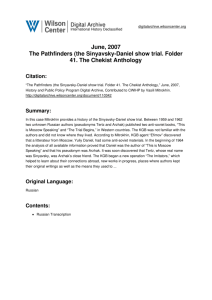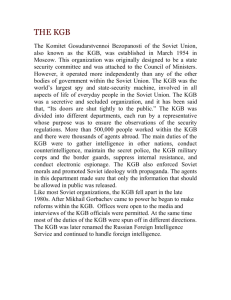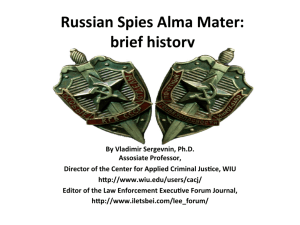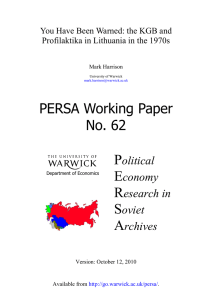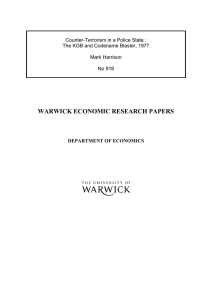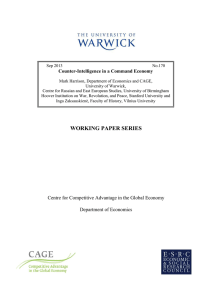If You Do Not Change Your Behaviour : Managing Threats
advertisement
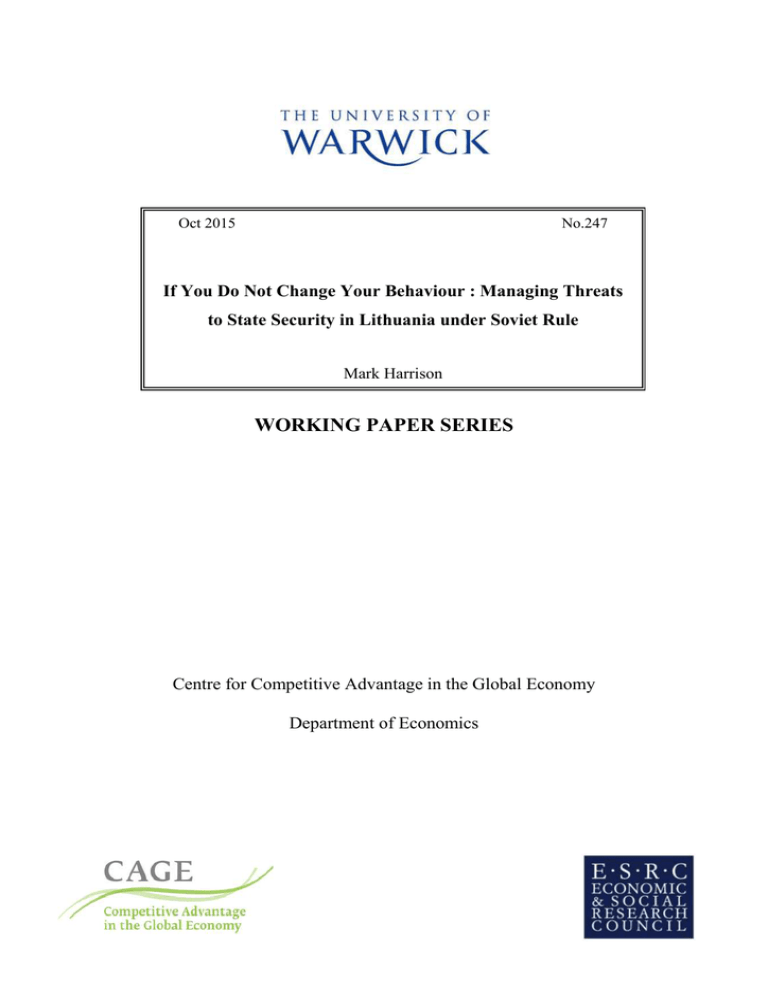
Oct 2015 No.247 If You Do Not Change Your Behaviour : Managing Threats to State Security in Lithuania under Soviet Rule Mark Harrison WORKING PAPER SERIES Centre for Competitive Advantage in the Global Economy Department of Economics If You Do Not Change Your Behaviour: Managing Threats to State Security in Lithuania under Soviet Rule Mark Harrison* Centre on Competitive Advantage in the Global Economy, University of Warwick Centre for Russian, European, and Eurasian Studies, University of Birmingham Hoover Institution on War, Revolution, and Peace, Stanford University Abstract In Soviet Lithuania (and elsewhere) from the 1950s to the 1980s, the KGB applied a form of "zero-tolerance" policing, or profilaktika, to incipient threats to state security. Petty deviation from socio-political norms was regarded as a person's first step towards more serious state crimes, and as a bad example for others. As long as petty violators could be classed as confused or misled rather than motivated by anti-Soviet conviction, their mistakes would be corrected by a KGB warning or "preventive discussion." Successful prevention avoided the costly removal of the subject from society. This represented a complete contrast to the Stalin years, when prevention relied largely on eliminating the subject from society. Preventive discussions were widely practised in many different circumstances. KGB internal evaluations concluded that these discussions were extremely effective in preventing further violations. This was the front line of the Soviet police state; it was perhaps the largest programme for personally targeted behaviour modification anywhere in the world at that time outside the education sector. It was also a front line of the Cold War because the foreign adversary was seen as the most important source of misleading or confusing influence. My work in progress aims to understand the origins and operation of profilaktika, including how and to whom it was applied, how it worked on the individual subject, and its wider influence on the Soviet Union’s social and political order. Keywords: coercion, communism, deviance, nudge, security, social norms, surveillance, Soviet Union, zero-tolerance. JEL Codes: N44, P37. * Mail: Department of Economics, University of Warwick, Coventry CV4 7AL, United Kingdom. Email: mark.harrison@warwick.ac.uk. Work in progress. First draft: 25 October 2015. If You Do Not Change Your Behaviour: Managing Threats to State Security in Lithuania under Soviet Rule1 [She] was warned that, in the event of a repetition on her part of similar remarks, more severe measures of influence would be applied to her. 2 Introduction Just forty years ago, on 31 October 1975, KGB chairman Yurii Andropov made a “top secret” report to the members of the Central Committee of the ruling Soviet Communist Party. The subject of his report was perhaps the largest and most effective programme for personally targeted behaviour modification anywhere in the world at that time outside school and college.3 This is a paper to a panel on “Identifying the Enemy: Secret Policing and Censorship in a Frontline Soviet Republic” at the annual convention of the Association for Slavic, East European, and Eurasian Studies, Philadelphia, 20 November 2015. Preliminary versions of this paper were presented (under a slightly different title) to the Department of Economic History of the London School of Economics on 19 March 2015, the History Faculty of the University of Vilnius on 15 May 2015, and the CAGE Conference on Institutions and Social Norms in Economic Development at the University of Warwick on 11 July 2015. I thank the participants for discussion, Ed Cohn and Amir Weiner for advice, Ed Cohn and Amanda Swain for giving me access to their unpublished work, and Yulia Bashirova for research assistance. I am grateful to the Hoover Institution for its generous hospitality and support of the annual Hoover Institution Workshop on Totalitarian Regimes; and the staff of the Hoover Library & Archives for their patience and expertise. The uses of personal data for this project are governed by conditions agreed with the University of Warwick’s Humanities & Social Sciences Research Ethics sub-committee. 1 Hoover Institution Library & Archives, Lietuvos SSR Valstybes Saugumo Komitetas, Selected Records of the Lithuanian Special Archive (Lietuvos ypatingasis archyvas – LYA), collection K-1, inventory 3, file 682 (hereafter Hoover/LYA Hoover K-1/3/682): 12-12ob (Klaipeda KGB first division commissioner lieutenant Kulikov, report on implementation of profilaktika, 12 December 1970). 2 I believe this must be the case. Stalin did not use preventive warnings; his remedy for enemies, including "potential" and "unconscious" enemies, was to remove them. The Chinese did not use preventive warnings as far as I am aware, because they lacked the 3 Work in progress. First draft: 25 October 2015. 2 In the war on anti-Soviet activity, Andropov said, we are winning. He began by pointing to a steep decline in the number of prosecutions for state crimes such as treason and anti-Soviet agitation—from more than 1,300 a year at the end of the 1950s to less than half that number in the early 1970s. The figures he used are shown in Table 1. But what factors were driving this success? Andropov proposed four factors: The further reinforcement of the moral-political unity of our society; the growth of political consciousness of Soviet people; the correct penal policy of the Soviet state; and the dominant role of preventivewarning work to deter criminality (my emphasis). In Andropov’s analysis, behind the decline in crimes committed lay an increase in crimes prevented. Andropov went on to show that the KGB was issuing preventive warnings to tens of thousands of people each year—and that these warnings were outstandingly effective. Out of the 120,000 that received such a warning between 1967 and 1974, just 150, or barely more than one per thousand, were subsequently brought to court charged with a state crime. In short, prevention worked. Prevention was the core mission of KGB counter-intelligence: to frustrate the activities of foreign intelligence agencies and to suppress “the disruptive activities of the organizations and persons that they exploit” (Nikitchenko et al. 1972). This mission required both punitive and preventive actions, symbolized by the sword and shield of KGB insignia. In Stalin’s time, the sword ranked above the shield, which was little used. Andropov’s data show that, by his time, actions of the shield outnumbered those of the sword by twenty to one. Under Khrushchev and Brezhnev, the system of preventive warnings became the front line of the KGB struggle with individual nonconformity in Soviet society. The growing emphasis on profilaktika was acknowledged in private (Chebrikov et al. 1977: 503-504) and has since been outlined in the published work of political scientists and historians (Knight 1990: 184, 193-197; Elkner 2009: 153-156; Fedor 2011: 51-56; Hornsby 2014: 211-212). As yet, we lack detailed evaluation of its scope, working methods, and outcomes (but look out for Cohn 2015, in preparation). The project summarized in the present paper aspires to fill in a few of the blank spaces. capacity it required, and they relied on mass struggle to align personal behaviour, not personal threats or suasion. And I cannot think that there was another large population on which a similar method was practised. Capitalist advertising does not count; at this time it was not personally targeted, and besides it did not threaten anyone with the consequences of failure to respond. If you know differently, however, contact me. 3 Table 1. Prosecutions for state crimes and preventive warnings in the Soviet Union, 1959-1974 1959-62 5,413 1963-66 3,251 1967-70 2,456 1971-74 2,423 Prosecutions, total Of which, for: Treason 1,010 457 423 350 Espionage 28 8 10 9 Anti-Soviet agitation and propaganda 1,601 502 381 348 Smuggling 47 103 183 474 Violation of currency regulations 587 474 382 401 Illegal border crossing 926 613 704 553 Disclosure or loss of state secrets 22 31 19 18 Other crimes 1,003 1,011 328 Preventive warnings, total … … 58,298 63,108 Of which, for: Having suspicious contact with foreigners or holding treasonous intentions … … 5,039 6,310 Taking part in antiSoviet activity … … 35,316 34,700 Warned with involvement of the public … … 23,611 27,079 Of which: At general gatherings of workers and staff, in comradely courts, etc. … … 10,624 11,836 In the form of discussion with representatives of public opinion … … 12,987 15,243 Formally cautioned (1973-74 only) … … … 981 Tried on criminal charges, of those preventively warned … … 100 50 Source: The figures reported here were first published by Pikhoia (1998: 365-366). A copy of the original is found in the Hoover Institution Library & Archives, Dmitrii Antonovich Volkogonov papers, container 28 (reel 18) (USSR KGB chairman Yuri Andropov, memorandum “Concerning some results of the warning and preventive work of the organs of state security,” 31 October 1975). 4 Evidence My evidence base is KGB records from Soviet Lithuania, held on microfilm at the Hoover Institution, based on paper records in the Lithuanian Special (KGB) Archive: more than a million pages of risk assessments, action plans, case files, reports, audits, bulletins, correspondence, and transcripts of interviews and meetings from 1940 to the 1980s. In the course of preparing this project I have begun to collect documentation on two aspects of profilaktika, its evolution and its practice. As discussed below, evidence from the Baltic cannot provide a complete picture of the history, but is certainly suggestive. As for the practice of profilaktika, this paper reports work in progress. I have assembled hundreds of records of “preventive discussions.” The records are being digitized; at a later stage of this project, I will anonymize them, code them, and turn them into data for quantitative analysis. In framing these objectives, I draw on several secondary literatures in history and social science. The problem of public loyalty and private dissent under communism has been dissected by Inkeles and Bauer (1959), Kuran (1989), and Wintrobe (1998). The role of the KGB in Soviet rule is the subject of Knight (1990), Albats (1995), Weiner (2006); Fedor (2011), and Hornsby (2014). The establishment of Soviet rule in the Baltic has been mapped out by Reklaitis (2007), Tannberg (2010), Statiev (2010), and Weiner and Rahi-Tamm (2012). Mass disturbances under communism are catalogued by CIA (1983) and Kozlov (1999); on the bloody suppression of particular outbreaks see Baron (2001) and Barenberg (2014). In this short paper I give some attention to the Kaunas events of 1972, detailed by Swain (2013). A public health mission The language of profilaktika owes something to political epidemiology. In this view of human behaviour, words and actions that undermine the existing order are “unhealthy.”4 Initial outbreaks are random and unpredictable but, once established, they can spread like a communicable disease. In this analogy, some people carry infection, while others are susceptible. When a disease breaks out it spreads through informal networks that bring susceptible people into contact with carriers. Some are more susceptible than others, in particular young people and The subject of a preventive warning, “while in a café, made unhealthy remarks” on various topics, including “specifically in relation to persons of Russian nationality.” Hoover K-1/3/682: 25-27 (Klaipeda city and Lithuanian seaport KGB first division senior lieutenant Kelauskas, report on profilaktika, April 1970). 4 5 educated people. The disease spreads first among persons of higher susceptibility. If unchecked, as levels of exposure increase, it can also spread to those less susceptible and become endemic. In any society, the control of infectious diseases requires public health institutions. It is no surprise to find that in the field of “unhealthy” behaviour the KGB carried out all the functions of a public health organization. These began from historical records and mass surveillance and extended to protective isolation, triage, and intervention.5 KGB records and surveillance allowed the use of personal markers (“kompromat”) to identify the most likely carriers of disloyalty. The KGB obtained these markers partly from past records of individual and family attributes and attitudes, partly from current signals by informants. Informants were a scarce resource, and the KGB deployed them particularly where those most at risk of infection tended to gather: the educational, science, and production establishments that trained and employed bright young people (Harrison and Zaksauskienė 2015). In turn, mass surveillance formed the basis for rapid intervention. As one would expect of a public health agency, KGB intervention began with triage, identifying the three classes of people that could be respectively removed, treated, or ignored. Figure 1. Triage of Citizen X Citizen X Behaves well Behaves badly Ignore Disclaims loyalty OR Repeat offender Punish Claims loyalty AND First offender Treat Note: KGB triage is not described anywhere in exactly these terms, but is easily inferred from the distinctions made in KGB training documents such as Nikitchenko et al. (1972) and Chebrikov et al. (1977). Figure 1 illustrates the criteria that qualified Citizen X for any one of these three options. At one extreme, intentional perpetrators of state crimes merited removal (to prison, exile, or the death cell), which would Thus a 1964 resolution of the KGB collegium included “protection of Soviet citizens from bourgeois ideology” among the goals of profilaktika, cited by Chebrikov et al. (1977: 584) and noted by Elkner (2009: 152). 5 6 punish them and protect society. At the other extreme, citizens that were already sufficiently immunized by government schooling and party propaganda would conform to authorized norms of behaviour without treatment and could be ignored. In between was the middle group, the “politically immature, confused” citizens who from time to time committed “politically damaging misdemeanours” that were not yet state crimes but could become state crimes if unchecked (Nikitchenko et al. 1972: 220, 237). As long as these people did not declare an intention to cause harm to the Soviet social and political order, they could be treated by profilaktika, allowing them to remain in society. An incomplete history Profilaktika originated in the 1930s as a concept, from which it evolved in the 1940s and 1950s into an expedient; only in the 1960s did it become the central element of the KGB strategy for achieving regime security. Our view of this history is incomplete because most of it lies hidden in Russian state archives that have never been opened. The concept of profilaktika can be traced back to February 1934 (if not earlier), when OGPU chief Yagoda defined the goal “to prevent crime before it happened rather than react to crime after it occurred” (Shearer 2009: 125). At that time, Shearer notes, the security police lacked the capacity to implement the concept. Prevention of potential state crimes gave way to imprisoning and killing potential state criminals. After the war, and perhaps even before, profilaktika became an expedient. We can see only what happened in the Baltic region, but this is enough for informed guesswork. The two occupations evidently gave rise to new problems that demanded new solutions. Immediately, there was the problem of what to do with the priests of the Catholic Church in the western borderlands, given that it was decided not to imprison them all.6 In the early 1950s, another problem specific to the western borderlands became acute: how to bring back into society (“legalize”) those young men that had taken to the forests at the end of the war. In the mid-1950s a Already on the occasion of the first occupation of Lithuania in 1940, Moscow recommended preventive warnings for the NKVD toolkit to manage the Catholic Church. “Make a practice of summoning the bishops to the NKVD with the aim of warning them of [their] responsibility for the anti-Soviet actions of the priests under their rule.” Hoover/LYA, K1/3/149: 125 (USSR People’s Commissar of Internal Affairs L. Beriia and head of chief administration of state security Merkulov, memo to Soviet Lithuania People’s Commissar of Internal Affairs Guzevičius, no date but not later than January 1941). 6 7 third problem arose when tens of thousands of former prisoners and “special settlers” came home from Siberia. Each of these groups was substantial in number and included people who could be thought of as relatively dangerous to the regime. Preventive warnings generally turned out to be an effective way of managing them.7 One supposes (but direct evidence is lacking) that in Moscow someone made the following calculation: if preventive warnings could manage the relatively dangerous people, who were numbered in tens or hundreds of thousands, but were still only a tiny percentage of the total Soviet population, would the same methods not also work in the less dangerous cases that were potentially far more numerous? Somehow or other, within thirty years profilaktika moved from concept to expedient to strategy, eventually becoming the key to regime security that Andropov described to the Central Committee in 1975. Application and scope Anyone who studies profilaktika has a favourite story.8 Here, for reasons of space, the reader must make do with Amy Knight’s (1990: 184) summary: If for example the KGB learns that a Soviet citizen is having contact with foreigners or is speaking in a negative fashion about the Soviet regime, this citizen is called in for a “chat” and efforts are made to set him or her straight. The chat was not violent and it specifically did not take the form of an interrogation (Elkner 2009: 153). It was meant to be a two-way exchange that would lead to mutual understanding. The KGB wanted to understand the causes of the subject’s bad behaviour and help the subject understand the possible consequences. The discussion could be two-way, but it was For example, returnees from Siberia: Hoover/LYA, K-1/3/557: 2-5 (Soviet Lithuania KGB commissioner for Balninkai district Šatas, report “On the status of work among persons returning from detention and special settlement,” 21 April 1959) and many similar district reports. On numbers in various categories subjected to profilaktika see for example Hoover/LYA, K-1/3/558: 41-48 (Soviet Lithuania KGB commissioner for Varniai district captain Misonas, report “On the status of agent-operative work in relation to bourgeois nationalists and returnees from places of detention, exile, and special settlement on the territory of Varniai district,” 5 September 1959) and many similar district reports. 7 8 Some of mine are told in Harrison (2015: chapter 5). 8 not open-ended. There was always a desired outcome, which was for the subject to acknowledge having made a mistake and to pledge to correct it. At a later stage of this project I expect to give a more precise account of the scope of profilaktika—the range and frequency of types of persons and of behaviours that merited preventive treatment. For the time being, my impression of cases that seem to recur in the files includes people who got drunk and praised capitalism or spoke out against communism; who passed on subversive jokes; who wrote anonymous letters or leaflets; who were too curious about secret matters (including most political, economic, and military matters); who were too interested in foreign and pre-Soviet culture and art; who listened to foreign radio broadcasts and passed on what they heard; who met foreign visitors without permission; who did what young people often do in ports (trade with foreigners in goods, currency, and sex); or who behaved badly while travelling abroad or at the border. As can be seen from Table 1, profilaktika could be applied to individuals and to groups; the latter were relatively infrequent but extended to numbers of persons in double figures. Profilaktika could be delivered in private or public, but the artistic direction and stage management of public warnings clearly required more effort, and KGB documents often imply that they should have done more along this line. The Kaunas events A case study in the wider exercise of profilaktika is provided by the Kaunas events of 1972. These events began with young people in a public square and a heroic, suicidal gesture (for a contemporaneous account see Remeikis 1972). There were two days of demonstrations in Kaunas and minor disorders in a dozen other towns. These disorders expressed deepseated grievances, but did not give rise to persistent turmoil. They were quickly suppressed by force; the force was calculated and discriminating, without bloody reprisals, mass arrests, or executions. This outcome is remarkable in two contexts, one being our knowledge of mass disturbances under communism, in which episodes involving violent, incompetent state thuggery are salient; the other being the intense national resistance to Soviet rule in Lithuania before 1953 and after 1987. In 1972, apparently, secret police work in Lithuania was effective. How was it done? The answer seems to be: mostly by normal methods and, in particular, by the intensified application of profilaktika. Numbers involved in the disturbances to public order were 3,000 to 3,500, or around one in 12 of the population of Kaunas aged 15 to 24—an impressive turnout, given that any coordination was strictly informal and was confined to word of mouth and the phone. On the first day 400 9 demonstrators were arrested; on the second day none were arrested although many were beaten. After that, there were no more mass disorders, but there were many minor incidents in a dozen small towns around Lithuania (catalogued by Swain 2013). The protestors’ profile can be inferred from those detained. These were mostly male, aged 15 to 24; most were in work, school, or college. They were not typical citizens of Lithuania, but they were not drop-outs or marginal elements; one in four belonged to the Komsomol. If anything, they were typical prospective members of Soviet Lithuania’s future elite. Once the streets were cleared, KGB triage went to work. Official punishment was highly selective. Only 40 of the detained, around one in a hundred of the demonstrators, received a formal punishment, and for most of these the penalty was 10 to 15 days in the police cells, imposed without a court hearing. Eight young people were set aside as enemies, to be removed from society. They were put on trial, charged with violent disorder, and imprisoned for one to three years. They were chosen, evidently, on three criteria: from the 500 that were first to gather on the evening of the funeral; from the front row of the marchers on the first day of demonstrations; and from those with an existing police record.9 No one was killed or executed. In noting this I do not mean to trivialize the impact on the lives of the young people who were singled out for imprisonment. But, when compared to the blood spilled indiscriminately on the streets of Novocherkassk, Budapest, and other cities under similar circumstances, the outcome was a model of restraint. While a handful were punished, many were warned. Again, KGB triage was at work. The documentation divides the detainees into two groups, workers and students. Nearly two hundred blue-collar workers were detained. For them, the standard treatment was “preventive conversations … measures of an educational character … exploits were discussed in workplace meetings.” A few were given a rougher time: “Some individual ill-intentioned violators of labour discipline” were disciplined (probably demoted or moved to lower paid work).10 Also detained were nearly 150 school and college students. These were also taken down the route of the preventive conversation. At the same time, many were quietly expelled from their courses. This would Hoover/LYA, K-1/3/793, 142–149 (Lithuania KGB chairman Juozas Petkevičius, report, not dated but May 1972). 9 Hoover/LYA, K-1/3/703: 170–174 (Lithuania KGB Kaunas city chief Bagdonas and third division chief Trukhachev, “Report on measures for implementation of the decree of the Lithuanian Communist Party central committee of 30 May 1972,” 17 August 1973). 10 10 have broken up their classroom friendship networks, forcing them out into the frostier world of work quotas and hierarchies of seniority. As far as most participants in the Kaunas disturbances were concerned, therefore, the KGB response was simply to continue to do what it had done before, but to do it more systematically and more intensively. Moreover, this strategy worked. How profilaktika worked In a post-mortem on the Kaunas events, the KGB commented on the heavy application of profilaktika: Such measures, as a rule, have positively influenced not only those preventively warned, but also those around them, and have helped to uncover the factors giving rise to unwanted manifestations, to eliminate defects, and to improve educational work in the college and workplace collectives of those being warned.11 In line with the phrasing of this assessment, it is convenient to think about the aggregate effects of profilaktika in two parts, the primary effect on the subject, and a consequential or secondary effect on the subject’s contacts, and through this more generally on society as a whole. Primary effect: “Those preventively warned” Of 885 persons interviewed over 18 months from 1 January 1973, the KGB reported, only 9 (one per 100) had to be warned a second time. So the message from Kaunas to Yurii Andropov was: You’re right! The rate of recidivism following a KGB preventive warning was astonishingly, magically low. How did the magic work? The primary effect on a person was achieved in a few minutes. KGB records of preventive discussions show, in nearly all cases, that in the course of a single conversation the subject worked from shock and confusion through denial and negotiation to acceptance of the KGB’s censure of their behaviour and a clear promise to change course. (I hope to be more precise in a future version of this paper.) The preventive discussion was, apparently, a life-altering moment. Hoover/LYA, K-1/3/717: 123–130 (Lithuania KGB fifth department deputy chief Stalauskas, second administration third department deputy chief Grishechkin, and senior inspector under the Lithuania KGB chairman Malakhov, “Report on the condition of preventive work in the Lithuania KGB and measures to improve it,” 17 October 1974). 11 11 Reading between the lines, one cannot avoid the conclusion that the key to the primary effect was fear. In the opening minutes of the discussion, the subject learned that the KGB had easy access to their private life, attitudes, and behaviour. This access arose from betrayal by the subject’s confidants, even if their precise identity was generally concealed. Isolated and compromised, the subject was also threatened with severe consequences of persisting on the course previously set. The subject had every reason to fear these consequences. In the recent past, the KGB’s predecessor had executed millions and imprisoned or resettled tens of millions. In the present, the KGB had authority to intervene in any aspect of the life of the citizen and the citizen’s family members far beyond the limits of a conventional police agency, including in residence, school, work, prospects for further education and promotion, opportunities for foreign travel, and even psychiatric status. The discussion changed the subject’s course; did it also change minds? There is no reason to think so. But most likely the KGB did not expect sincere repentance. In the 1950s Alex Inkeles and Raymond Bauer interviewed thousands of Soviet emigrants about their experience of Soviet rule. They concluded (1959: 283) that Soviet rulers understood perfectly that many of their citizens held grievances and would have disloyal thoughts. They did not expect inner loyalty. They were satisfied to “assure reliable behavior regardless of how the citizen might feel about the regime.” Secondary effect: “Also those around them” The direct influence of the preventive discussion on the subject was only the start, however. If it was also the finish, it could not be a large effect on the community, for profilaktika was not practised on a large enough scale to reach significant numbers of people directly. Table 2 shows that, in eight years, profilaktika touched the lives of fewer than one per thousand residents of Soviet Lithuania (perhaps one in five hundred of those in work and college)—and the rate for the Soviet Union as a whole was only half of the rate in Lithuania. Over the same period, in other words, 99.8 percent of working-age Lithuanians had no direct contact with the KGB. KGB officers maintained that the changed behaviour of “those preventively warned” exerted a wider influence on “those around them” at home, at work, at school or college, and in the neighbourhood, by force of example. Only when the secondary (or exemplary) effect is taken into account can we ascertain the aggregate effect of profilaktika on society. The exemplary effect of coerced conformity was already noted by Inkeles and Bauer (1959: 290). When the citizens inclined to disloyalty could be coerced into the appearance of loyalty, and those watching them followed their example out of the perceived lack of any viable alternative, everyone 12 obtained “an exaggerated picture of actual loyalty” which in turn reinforced and sustained the status quo (see also Kuran 1995: 261-276). Table 2. Rates of preventive warning, 1967 to 1974, Soviet Union and Soviet Lithuania Soviet Union 241.7 million Soviet Lithuania 3.128 million Resident population, 1970 Preventive warnings (1967-74): Total 116,406 2,987 Per million residents 481 955 Per million per year 60 119 Sources: Resident populations on 15 January 1970 are from TsSU (1972: 10). Persons subject to preventive warning, 1967 to 1974: in the Soviet Union, calculated from Table 1, and in Soviet Lithuania, calculated from annual figures compiled and tabulated by Cohn (2015). Thus the aggregate effect of profilaktika combined coercion of a few with the persuasion of many. This combination suggests how a regime could have coercion at its core, yet millions would live their lives without personal experience of it. Every citizen heard the party propaganda and saw the realities of their own lives. Very many were likely to have had some experience of secrecy and censorship. But the great majority had no personal contact with the KGB. They felt the influence of KGB coercion only through what they did not see or hear: the colleague or neighbour who used to complain, used to share a joke and pass on a rumour, or used to voice the dream of a different life, but did so no longer. Preliminary conclusions In Soviet society most people would fall into line with official norms provided they were not exposed to infectious examples of “unhealthy” nonconformist behaviour. Good examples and an absence of bad ones would nudge them into the uniform template of “healthy” behaviour and keep them there. A small minority, however, would be kept in line only by an unmistakeable and unforgettable threat. The primary and secondary effects of profilaktika matched the requirements of each group. The primary, coercive effect was on the minority. Based on mass surveillance, the KGB identified the few that merited a threat and delivered it personally to each of them, securing their cooperation in nearly all cases. While the numbers frightened into conformity remained tiny in relation to the large Soviet population, they reached tens of thousands per year. These figures suggest that, by the 1970s, the KGB’s use of “preventive warnings” had become the largest 13 and most effective programme for individually targeted behaviour modification in the world outside an educational setting. Profilaktika also had a wider influence without which it could not have been effective. In the wider community, the reformed behaviour of those that had been personally threatened set a persuasive example that calmed society and reinforced mass conformity. The result was a political equilibrium, one that was conditionally stable, but primed to break down when the minority ceased to fear the consequences of self-expression. References Albats, Yevgenia. 1995. KGB: State Within a State. London: I. B. Tauris. Barenberg, Alan. 2014. Gulag Town, Company Town: Forced Labor and Its Legacy in Vorkuta. New Haven: Yale University Press. Baron, Samuel H. 2001. Bloody Saturday in the Soviet Union: Novocherkassk, 1962. Stanford: Stanford University Press. Chebrikov, V. M., G. F. Grigorenko, N.A. Dushin, and F. D. Bobkov, eds. 1977. Istoriia sovetskikh organov gosudarstvennoi bezopasnosti. Uchebnik. Moscow: Vysshaya Krasnoznamennaya shkola KGB pri SM SSSR imeni F. E. Dzerzhinskogo. URL: http://www.fas.harvard.edu/~hpcws/documents.htm. Cohn, Edward. 2015. “Profilaktika and the Roots of Unrest: The Obshchestvennost’ Campaign and the KGB’s Use of ‘Prophylactic Measures’ in the Republic of Lithuania, 1953-1964.” Grinnell College: working paper (in preparation). Elkner (Fedor), Julie. 2009. “The Changing Face of Repression Under Khrushchev.” In Soviet State and Society under Nikita Khrushchev, pp. 142-161. Edited by Melanie Ilič and Jeremy Smith. Abingdon: Routledge. Fedor, Julie 2011. Russia and the Cult of State Security: The Chekist Tradition, from Lenin to Putin. London: Routledge. Harrison, Mark. 2015. One Day We Will Live Without Fear: Everyday Lives Under the Soviet Police State. Stanford: Hoover Institution Press (forthcoming). Harrison, Mark, and Inga Zaksauskienė. 2015. “Counter-Intelligence in a Command Economy.” Economic History Review (forthcoming). Hornsby, Robert. 2013. Protest, Reform, and Repression in Khrushchev’s Soviet Union. Cambridge: Cambridge University Press. Inkeles, Alex, and Raymond A. Bauer. 1959. The Soviet Citizen: Daily Life in a Totalitarian Society. Cambridge, MA: Harvard University Press. Knight, Amy W. 1990. The KGB: Police and Politics in the Soviet Union. Boston: Unwin Hyman. 14 Kozlov V. A. 1999. Massovye besporyadki v SSSR pri Khrushcheve i Brezhneve. Novosibirsk: Sibirskii Khronograf. Kuran, Timur. 1995. Private Truths, Public Lies: The Social Consequences of Preference Falsification. Cambridge, MA: Harvard University Press. Nikitchenko, V. F. and 16 others, eds. 1972. Kontrrazvedyvatel’nyi slovar’. Moscow: Vysshaya kranoznamennaya shkola Komiteta gosudarstvennoi bezopasnosti pri Sovete Ministrov SSSR imeni F. E. Dzerzhinksogo, Nauchno-izdatel’skii otdel. URL: http://www.genocid.lt/KGB/ci_dictionary.pdf. Pikhoia, R. G. 1998. Sovetskii Soiuz: Istoriia vlasti, 1945-1991. Moscow: RAGS. Reklaitis, George. 2007. “Cold War Lithuania: National Armed Resistance and Soviet Counterinsurgency.” The Carl Beck Papers in Russian & East European Studies 1806. University of Pittsburgh: Center for Russian and East European Studies. Remeikis, Thomas. 1972. “Self-Immolation and National Protest in Lithuania” and “Eyewitness Report of Demonstrations in Kaunas, Lithuania, Following the Self-Immolation of Romas Kalanta, May 18– 19, 1972.” Lituanus: Lithuanian Quarterly Journal of Arts and Sciences 18(4), pp. 58–69. Shearer, David R. 2009. Policing Stalin’s Socialism: Repression and Social Order in the Soviet Union, 1924-1953. New Haven: Yale University Press. Statiev, Alexander 2010. The Soviet Counterinsurgency in the Western Borderlands. Cambridge: Cambridge University Press. Swain, Amanda Jeanne. 2013. “A Death Transformed: The Political and Social Consequences of Romas Kalanta’s Self-Immolation, Soviet Lithuania, 1972.” PhD diss., University of Washington. Tannberg, Tynu. 2010. Politika Moskvy v Respublikakh Baltii v poslevoennye gody (1944-1956): issledovaniia i dokumenty. Moscow: Rosspen. TsSU SSSR. 1972. Narodnoe khoziaistvo SSSR. 1922-1972. Iubileinyi statisticheskii sbornik. Moscow: Statistika. Weiner, Amir, and Aigi Rahi-Tamm. 2012. Getting to Know You: The Soviet Surveillance System, 1939-1957. Kritika 3(1), pp. 5-45. Wintrobe, Ronald. 1998. The Political Economy of Dictatorship. Cambridge: Cambridge University Press.



